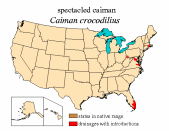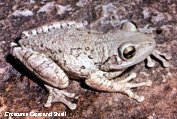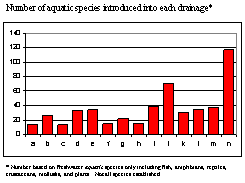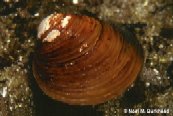 |
 |
 |
 |
 |
 |
 |
 |
 |
 |
 |
 |
 |
 |
 |
 |
 |
 |
 |
 |
 |
 |
 |
 |
 |
 |
 |
 |
|
|
|
|
|
 |
|
|
 |
|
|
|
|
|
Spiketop applesnail (Pomacea bridgesi)
This snail is a tropical freshwater species native to South America. It has been introduced into Florida and is now established in Broward, Dade, Monroe, Palm Beach, and Pinellas counties. It is usually greenish in color with dark and light bands. P. bridgesi is a popular aquarium snail and was probably introduced by aquarium hobbyists or fish farms. One important impact of this snail is that it may be replacing the native applesnail in the Everglades. The rare Everglades Kite feeds on the native applesnail but is not able to readily feed on the introduced species because of the shape of the shell does match that of the kite's beak (Hale 1964).
|
|
|
|
|
|
|
|
 |
|
|
|
 |
|
|
|
|
|
|
Daphnia lumholtzi
The native range of this daphnia is freshwater lakes of east Africa, southwest Asia, and east Australia (Havel 1993). It was first reported in Stockton Lake in southwest Missouri in 1991 and can be found in 13 states from Illinois and Ohio down to Texas across to North Carolina and south to Florida. D. lumholtzi has spread much faster than Bythotrephes for reasons unknown. The method of introduction is uncertain. But, coincidentally, one of its first appearances was a lake in Texas where the Nile perch was first introduced to North America (Havel 1993). It is well established in the U.S. Any effects or impacts are yet unknown.
|
|
|
|
|
|
|
|
 |
|
 |
|
|
|
|
Giant rams-horn snail (Marisa cornuarietis)
The giant rams-horn snail is native to northern South America and several of the southern islands of the Caribbean. It is an easily recognizable species, brick red in color with a flat coiled shell. Color may be darker or more vivid. Shell diameter is usually 35-50 mm (2 in.) or larger. Still or slow-moving fresh water, depending on vegetation. Easily adaptable to captivity, it may invade and damage aquarium vegetation. It is practically omnivorous and feeds on animal and vegetal detritus. Acts as a useful aquarium scavenger when not extensively numerous. It has gills as well as a lung, to ensure an efficient underwater respiration. A hermaphrodite, it lays eggs in characteristic disk-shape clutches adhering to various substrates. It is established in Broward, Dade, Monroe, and Palm Beach counties probably as a result of releases by aquarium hobbyists. Studies revealed that this species retards the growth of water hyacinths by feeding on the roots of the plants. It has been suggested that the snail be used as weed-control agent in the canals of south Florida. The snail has been released in some areas to control hydrilla. It has also been released to control snail populations that carry schistosomiasis.
|
|
|
|
|
|
|
|
 |
|
|
|
 |
|
|
|
|
|
|
Spectacled caiman (Caiman crocodilius)
Spectacled caimans are native to Central and Southern America. Although they look similar to native alligators, caimans can be distinguished by a bony ridge in front of their eyes. Coloration between the two species is also different - young alligators are black with yellow bands while caimans are greenish- to brownish-gray with dark brown bands. Adults attain a length of 6-8 feet. Caimans are established in Dade County, Florida, and have been reported in other areas of the country. They have also been observed in Everglades National Park. Discarded pets are the most likely source of introductions.
|
|
|
|
|
|
|
|
 |
|
|
 |
|
|
|
|
|
|
|
Greenhouse frog (Eleutherodactylus planirostris)
Greenhouse frogs were likely brought in on tropical plants from their native range in the Caribbean (Cuba, Bahamas, and Cayman Islands) and are now established in many areas of Florida. They are small frogs, only reaching 1.5" in length, and are active feeding, calling, and mating at night. Unlike other members of this genus, they are ground-dwellers (rather than arboreal) and are seldom found more than a few centimeters off the ground. They are most often found in leaf litter or under logs. The most unique trait of this frog (and other species of this genus) is that the eggs are laid in moist leaf litter, not water. The eggs then develop directly into tiny froglets, without going through a tadpole stage, a process known as direct development.
|
|
|
|
|
|
|
|
 |
|
|
|
 |
|
|
|
|
|
|
Cuban treefrog (Osteopilus septentrionalis)
Cuban treefrogs are believed to have been introduced into Florida in 1931 in cargo imported from Cuba. Since then they have spread to 27 counties. They are known to prey on many native frog species including the southern toad (Bufo terrestris), the narrow mouthed toad (Gastrophryne carolinensis), the southern leopard frog (Rana sphenocephala), the green treefrog (Hyla cinerea), and the squirrel treefrog (Hyla squirella), as well as other Cuban treefrogs. In some areas, these frogs have cause power outages. They are attracted to the buzzing noise of electrical transformers and can short out the transformer causing a localized blackout.
|
|



